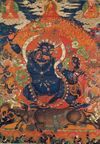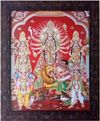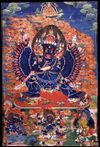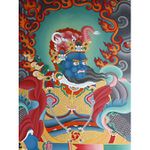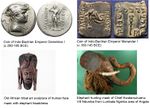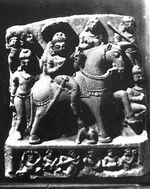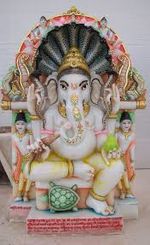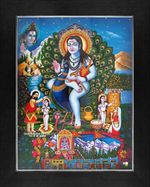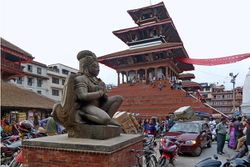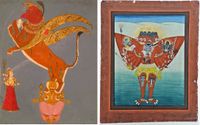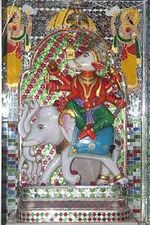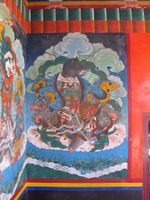Metaphors from Puranas explained
Because history is so ancient, going back to the prehistoric eras of Paleolithic, Neolithic, Chalcolithic, and Bronze ages, the need to carry history forward in the form on myths became essential as not everybody was literate and Hindus needed to pass down historical events orally. The Indian Subcontinent has had many ancient cultures and civilizations, such as Soanian (500,000–125,000 BP), Bihrrana (7570–6200 BC), Anarta (c. 3950–1900 BCE), Indus Valley (3300–1300 BCE), Black and red ware, Thrissur, Thoothukudi or Adichanallur (1800 BCE), and Vaigai or Keezhadi (1500 BCE) - all from different eras. Hence, all of the important historical events needed to be passed down from generation to generation.
Names of patriarchical persons or tribes are used metaphorically for either their descendants or followers. For example, names of rṣis being used to describe a person from that lineage (pravara gotra.) This can even be seen in the Sikh scriptures wherein it is declared that Guru Nanak met Guru Gorakh[1]. While the 2 lived centuries apart the stories are actually using the name of Gorakh metaphorically to refer to his followers, just like how Sikh scriptures metaphorically refer to Guru Arjan as the 5th Nanak. Another example is of how a story describing sants Nanak, Kabir, and Gorakh are sitting together having a discussion on God (again all 3 never lived in the same century.) A tribe-based example is how Hayagriva is mentioned numerous times but refers to different people, such as Dadhikra and Keshi. Both Hayagriva and Varaha[1] exist as the names of Daityas too. Another example is of the numerous wars that occurred between Asuras and Devas, the spiritual preceptor of the Asuras in every war is mentioned as Shukra. These wars occurred throughout many centuries so by 'Shukra' what is meant is the original son of Rṣi Bhargava and the descendants of that Shukra always being the priests and advisors of the Asuras. Names of at least 28 Vyasas have also been recorded in Vishnu Purana.
Also, just as various people can have the same name but be unrelated, similarly you find in texts that many people have the same name because their parents named them as such. For example, Laxmi is the name for at least 5 separate women of different eras; 1) Wife (daughter of Khyāti and Bhṛgu) of Vishnu, 2) Wife (daughter of Prasuti and Daksha) of Dharma (and mother of Kama), 3) Wife (daughter of Galava) of Dattatreya, 4) Wife (daughter of Puloman) of Indra, and 5) Wife (daughter of Jaldevi and Varuna) of Mahasani. Similarly there are 2 persons named Airavata - the Matanga son of Iravati and the Naga son of Kadru. Soma is the name of a Vasu and also of the son of Anasuya and Atri. There are also various Manus, Kapilas, and there are countless other examples of influential persons in Hindu literature having the same name.
Similarly a common mistake made by many people is to conflate 1 place with another because of similar names. For example, there are 2 Mandakini rivers, 2 Narmada rivers, 2 Vindhya mountain ranges, 3 Gokarna tirths, 3 Potalas, multiple Dwarkas, multiple 'Lankas', and several Gangas.
Another interpretation with names that must sometimes be made is with certain persons. 'Indra' is used to refer to many leaders of the Devas who also govern any of the Swargas. Some Indras have been recorded by names as leaders of different eras, such as Purandara of the Satya Yuga and Mahabali to be an Indra in the future. 'Mahabali' itself is also sometimes a title for any ruler of Vitala-loka just as the original Mahabali Vairocana was. Kubera has been used to refer to people in his lineage. Another example is how Hanuman is called "Pavana-putra" (Son of air) or the son of Vayu (Air) in the Valmiki Ramayana, not because he was the son of the Deva Vayu but because his father's name was Pavana, meaning air. Valmiki built on that fact to make it a pun.
The meanings of stories have to be interpreted in the proper context and judgement must be made when to take a story literally and when figuratively. For example, the Vamana Purana[2] states that sages Pitambara and Markendaya brought the Sarasvati River down from Swarga to Puskara city and the Kurukshetra region. This means that the rṣis built 2 important tirths or (places of pilgrimage) along the course of the river at Puskara and Kurukshetra, and that the rivers origins are in Himalayas (i.e., Swarga-loka.) Another example is the story of Mandapala in the Mahabharata. He was a childless saint who, after his asceticism, "died" and went to the abode of Yama (i.e., Central Kashmir.) There he assumed the form of a Sarngika bird and from a female of that species who was named Jarita had 4 children. The explanation of this myth is that sage Mandapala retired to Yamaraj and there married Jarita of the Sarngika totemic tribe and procreated 4 offspring. Another story is during the time of Emperor Mahabali when he usurped Amarāvati and the 33 Devas were forced to flee in the form of birds. This means that they disguised themselves as tribals of a bird gotra to avoid being identified and captive, much like the way Chanakya disguised himself as an Ajivika to not be captured by king Dhana Nanda‘s forces.[3]
Persons were depicted and described totemically so that Hindus could easily identify them from the vast array of historical figures. Even on flags, animal symbols were the most common icons. Asura Bali's flag contained a serpent, Hanuman's of a monkey, Krishna's varying between Hanuman's flag in the Mahabharata and a flag of Garuda during his war with Bali, and Skanda's is of a hen. Totemic tribal identification was common in the ancient era, and there were different tribes represented by the same animal. For example, both Dandaśūkas (offspring of Krodhavaśā and Kashyapa) and Nagas (offspring of Kadru and Kashyapa) had the snake totem, while Kashyapa's wives Tāmrā, Pataṅgī, and Vinatā gave birth to birds. Even the Mahasupina Jataka explicitly states that "bulls" are metaphor in the scripture.
Most places are mythologized as being in another realm but are exaggerated descriptions of locations. One can see the remnants of totemic tribes' chiefdoms as typonyms, mentioned historically in texts and modern as placenames as well. Garuda Valley was actually a place on the Sutlej River. The Zhang Zhung Kingdom's capital is mentioned in Tibetan texts as Khyunglung Ngulkhar - the Silver Palace of the Garuda Valley.[4]
Pātalas and Swargas as regions within India[edit]
- See also: Kingdoms of Asura Dominance, Yama's kingdom is in Kashmir, Zarathustra was born in Kashmir, Olmo Lungring is in Karakoram, History of ancient geography
| Vyâsa said : “O King! On the top of the mountain Sumeru, are located the Indra's heavens called Amarâvati (the abode of the Immortals) the Samyamanî city of Yama, the Satyaloka, the Vahniloka, the Kailâsa, Vaikuntha the abode of Visnu, and others." | ||
—Mahabharata 8.6.16[5] | ||
Although these paradises, all termed 'lokas' (worlds or realms) have been made to appear as unearthly heavens, they are regions adjacent to 1 another as is evident from their geographic descriptions. This can be seen by people moving from region to region and physical features, such as mountains and rivers, which run course through them. An example is the Yamuna River described as leading Sita to Rasātala. Another example is of the deluge that impacted Shraddhadeva Manu wherein "the earthly paradise" of Bhu-loka, Bhuvar-loka and Swarga-loka were flooded.
Several paradises have been mentioned, and in many cases they've been identified with individuals. For example, Sukhavati with the Bodhisattva Amitabha, Shambhala with Manjushri, and Olmo Lungring with Shenrab.
Disguising as Brahmans[edit]
There are several stories wherein a person is described as having taken the form of a Brahman. This alludes to the person in question actually being a Brahman. For example, in 1 story Virocana is said to have given his own head in the form of a Brahman to Indra as a gift. This means that Virocana (who was never described as a Brahman in any text) has given his head- or chief-priest to Indra as a gift. Similarly, Gautama Buddha was shielded by torrential rainfall by Naga King Mucalinda in the form of a Brahman. This means that either the Naga king himself was a Brahman who offered Buddha refuge or that 1 of the king's Brahmans was ordered to do so.
Self-sacrificing and Punishment[edit]
Sacrificing One’s Head[edit]
•Bandara Basava had his head cut off at Cuttack to prove that Shiva was God and on the seventh day since having offered the sacrifice, by the grace of Siva he obtained a fresh head
•Ekāntada Rāmayya offered his own head to Shiva
•Jambur Lingayat offered his own head to Shiva
•Kali is said to have offered her own head. In the image it can be seen that her blood is used as sustenance while procreation is occurring in front of her. The meaning behind this metaphor is self-sacrifice wherein Kali had sacrificed herself for the benefit of her [Kal] gotra.
•Purusha is said to have created the universe out of its own body parts
•Rambha offered his head to Agni
•Ravana offered 9 of his heads to Agni
•Virochana offered his head in form of Brahman. This means that he gave as gift to Prajapati one of his head priests/administrators
Removing Another’s Head As Punishment[edit]
These are exaggerations which embellish an even with a beheadings that never occurred:
•Brahma’s head was severed by Vatuka Bhairava, and the dead Brahma was revived by Shiva’s yoga
•Daksha’s head was severed by Shiva, and replaced with a goat’s
•Ganesh’s head was severed by Shiva, and replaced with an elephant’s
•Mahabali’s head was severed in war but reattached by Shukracharya
•Renuka’s head was severed by Parshurama but later reattached by him or reattached mistakenly with the head of another person
Other Sacrifices[edit]
•Raja Dilip Ikshvaku presented himself by fighting a lion to defend the life of a rṣi’s cow
•Raja Shibi Paurava offered his own flesh to an eagle so that eagle doesn’t eat the pigeon
Animal sacrifices[edit]
- See also: Animal rights, Animal sacrifices, Ethics of Hinduism
The sacrifices recommended for spiritual prosperity are metaphorical, which some mainstream scriptures, such as Mahabharata and Puranas, as well as Jain and Buddhist ones, elaborate.
Totemism[edit]
Totemic Demonyms[edit]
| Achala Muni was born of an elephant, and Kesa Pingala of an owl, and Agastya Muni from the Agasti flower, and Kushika Muni from the kusa grass, and Kapila from a monkey, and Gautam Rṣi from a creeper that entwined a saul tree, and Drona Acharya from an earthen pot, and Trittiri Rṣi from a partridge, and Parswa Rama from dust, and Sringa Rṣi from a deer, and Vyasa Muni from a fisherwoman... | ||
Gotras and royal cognizances are totemic symbolises. Hindus since the prehistoric ages have symbolically named their children after animals. The very word 'gotra' means cow stall, signifying totemism. 'Go' (cow) is used metaphorically for all animals, just like the term 'goshala' (animal shelter.) This is known in western languages as 'theriomorphy' and as 'zoomorphy'. Even demonyms of gotras and tribes are totemic, such as those mentioned in the Rig Veda and other early scriptures as the Upanishads. Notable in the Rig Veda are the Gotamas (Oxen), Kaushikas (Owls), Mandukyas (Frog-sons), Paravatas (Turtle-doves), Sunakas (Doggies), Vatans (Calves), and Vatsavats (Possessing calves.)[7] Some aggressor invader tribes of the Dasarajna War whom King Sudas and his Bharata tribe had triumphed over were the Ajas (Goats), Alinas (Bees), Kikatas (Horses), Matsyas (Fish), Pārāvata (Turtle-doves), Simyu (Lion cubs), and Visanin (Horned.) Other tribes mentioned in the Rig Veda include the Abhira (Serpents) and Nagas (Serpents.)
Further, 'Kashyapa' means tortoise, while 'Matang' means elephant, and 'Bharadwaja' means skylark. Scholars of non-paravara mGo-gnans or totemic tribes include, Badavavaktra (Hayagriva), Kuṣilāvacārya (Varaha) and Shabara-swamin (Shabara.)
Furthermore animal emblems remained very popular in use by monarchs on their dynasty's flags, including Chola Dynasty's tiger flag, Ratlam's Hanuman flag, and Seraikella's Garuda, lion, and swans flag.
Hybrid iconography of persons in literature[edit]
Ajas as goats[edit]
Daksha is portayed with the head of the goat.
King Ajamidha, ancestor or Pandavas and Kauravas, was the son of King Hasti by Aja.
Ajapārshva was one of the children of Arjun.
Bhairavas[edit]
‘Gaur’ is a word that’s applied to both bulls and buffalos. Even today there are Gaur communities of Rajputs, Chamars, and Brahmans.
Rudras as oxen[edit]
Shiva's attendant named Nandi is always represented in temples as a bull and Shiva himself is described as a bull. Why? Because the Rudras are the children of the cow-tribeswoman Surabhi and Kashyapa. The males of the Rudra tribe identify with the bull totem while the females with the cow.
| May we not anger you, Rudra, with our homage, nor with ill-praise, O bull, nor with joint invocation! | ||
—Rig Veda 2.33.4 | ||
Mahākāla is known to be a name of Shiva. Mahākālas are mentioned more often in Buddhist scriptures than Shaiv or other ones. They are normally depicted as bull-headed because the bull is Shiva's tribe. More commonly-known Bhairavas include Khandoba, Golu Devta, Swarnakarshana, and Vatuka.
A Mahākāla are also known as Bhairava. There are a few Bhairava Yakshas of Jain Tirthānkars. This includes Nakoda and Varuna.[8] Two Mahākālis were the Yakshas of Tirthānkars Sumatināth and Pushpadānta. Another Yaksha simple named Kalika and Kali were the attendants of Abhinandananāth and Suparshvanāth respectively.
Further, Gomukha the Yaksha of Tirthānkar Rishabh is believed to be Nandi. Gomidha was the Yaksha of Nemināth. Basically, they are a Rudra too.
An example of an asura from this gotra is Gomukha, the follower of Surapadma.
Mahishas as buffalos[edit]
Mahish and Mahishak are both mentioned in the list of ethnic regions of South Asia in the Mahabharata. Katyayani Durga, who is also called Gauri (Female Gaur Buffalo) was of the Mahish or Gaur clan of Sritala-loka Patala. The demonic king she slew was called 'Mahish-asura'. For relieving the subjects of tyrant Mahish-asura's domain, she has been worshiped by them since and by many other Hindus in general.
Mhasoba of Maharashtra was of this totem and is worshipped it there still today. Pottu Raja was minister to Kunitan of Kaushambi (lived 5 generations after Arjun Pandav’s great-grandson Janamejaya.) He is sometimes depicted having buffalo features, and is worshipped in Andhra Pradesh, Tamilnad, and Telangana.
While Gopalas (Cow herders) are believed to descend from Ne-Muni (the patriarch of Nepal) and normally recognized as the first ruling dynasty of Nepal, they were succeeded by the Mahishpal (Buffalo-herders) who established the Mahishpal-vamshi (Buffalo-herder lineage) dynasty.
A Yaksha also named Gauri was the attendant of Sreyansanāth.
Anupa is a gotra or kula within a gotra, and from it came Vadhryashva. John Ferguson McLennan and Eleanora Anne Brandam McLennan wrote the gotra is of the buffalo totem and Garga of the bull.[9] The word ‘anupa’ has been associated with buffalos. ‘Anupa mamsa’ refers to meats of animals from marshy places like of buffalos and yaks. Charak Acharya of the 1st century BCE grouped buffalos into the ‘anupa’ class of animals.
Gandharvas as half-birds[edit]
This totem refers to a water-bird, the plava.
The Yaksha of Tirthānkar Kunthunāth was Gandharva.
Gṛdhras as vultures[edit]
Grdhras like Jatayu were good, while Grdhrayatu was a raksasa.
Grdhrakuta (Vulture's Peak) was Gautam Buddha's favorite retreat and he gave many of his sermons there.
Guhyaks[edit]
Guhyaks, like other Yakshas, are normally described as attendants of Kubera.
They are of a few kinds of Ganas; the Matang (Elephant) and Mattamayurka (Peacock) are the major tribes among them. That we know both were considered as different bands of the same tribe from Ganesh and Kartikeya being called brothers born of Shiva and Parvati. (Ganesh’s mother would’ve been of the Matang band while Kartikeya’s of the Mayurka band.) Although the terms ‘Guha’, ‘Guhya(k)’ are almost always associated with Mayurkas, we know it can include Matangs because of some sources like the Ganapati Guhya Sadhana Nama by Amoghavajra. We know Mayurkas were Ganas too because of epithets like “Guhyak Gana” from the Kirātārjunīye and ‘Matrka-gana’ used for his mother. Plus, Ganesh is also called Guhabdhisthaya, Guhashayaya, Guhyachararataya, Guhyagamanirupitaya, and Guhyaya.
Revanta, their chief, is known from the Rig Veda to have been a son of Surya. Revanta is praised by Śālihotra in his work Śālihotra Saṃhitā. There is still a tradition of his worship during the Navratri festival.
In Mahabharata, Hataka Desa is mentioned as a [predominantly] Guhyak region. In recorded history, we find coins of the Yaudheya Kingdom with "Gana" minted in them[10], which demonstrates 2 important things; that they were familiar with their 'gana' Shaiv identity and the affiliation of Uttarakhand to the Guhyaks.
Another popular Guhyak is Sahkhacuda, an attendant of Kubera. Dirghajangha was yet another.
Bhumiyas as mountains[edit]
Bhumiyas, like Bhumiya Baba the Shaiv, Bhumiyaji[2][3] the Jain sasana-deva, and the Shakta Shailaputri are worshipped. Parvati is the most popular of this gotra and her very name is patronymic, meaning ‘’Daughter of the mountains.’’ Her father was Girija Himban and mother was Maina. Pomra was a Tibetan and is written to have met the Buddhist saint Padmasambhav. Sometimes, as in the case of Bhumiyaji, the yakshas are depicted as mountains. Pahari is a populous linguistic community in and around Himachal Pradesh, and its demonym means, ‘’People of the mountains.’’
Matangs as half-elephants[edit]
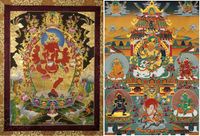
Ganesh was born in the western part of Uttarakhand by Dhudi Prayag (at the confluence of the Pundavati and Alakananda streams[11]), which is also known as Dhundhital and Dotidal[4][5].
The traditional stories about Ganesh having acquired an 'elephant-head' externally from Shiva having placed it onto Ganesh are popular.
In the world's tribal communities, animal headdresses have been popular, especially for priests to act as intermediaries to communicate between human and nature.
We know that Nila Gajasura was slain in battle by Shiva and his 'head' was placed atop Ganesh's body. This story is saying that the headdress crown of the Gaja tribe's chief Gajasura was taken by Shiva after the former's defeat and Shiva crowned Ganesh as the chief of the Ganas. Hence, Ganesh's title 'Ganapati' (Lord of the Ganas.) There is even a mountain in the Chamoli district of Uttarakhand called Hathi Parbat (Elephant Peak.)
A popular Bauddh venerated person from Ganesh's tribe are Rakta Jambhala, who is worshiped exclusively in Vajrayana Buddhism. Because Rakta Jambhala is of the Gana tribe, he too is called Ganapati. Ucchusma Jambhala is described as an incarnation of Vajrapani Guhyapati.[12] Guhyapati and Acharya Buddhaguhya are other popular Buddhist Guhyaks. Both the Guhya Samaja and the Tathâgata Guhya Sutra are Buddhist scriptures composed likely by Guhyaks. Other Shaiv Matangs include Mita, Sammita, Salakatankata, and Kusumandarajaputra.[13]
King Hasti, ancestor or Pandavas and Kauravas, and the establisher of Hastinapur city, was son of King Bṛhatkṣatra. King Prasenajit, described as Matang-kula (Of Matang-lineage) was a follower of Gautam Buddha in the latter’s era.
- Others depicted with elephant heads
Tso-ndzi Gkv-dzu is, like Ganesh, a king venerated by the Nakhi Bonpos of Sichuan and Yunan provinces of China. Dharanendra Yaksha (a.k.a. Vāmana Yaksha, Pārshva Yaksha) was attendant of the 23rd Jain Tirthānkar Pārshvanāth. He is depicted like Ganesh because he was of the same Guhyak gotra. Other Yakshas of Tirthānkars include 3 identified simply as as 'Matang' of the 7th (Shāntinath) and 24th (Mahāvira.) Dharanendra is called by the same tribal name. Vāranandi (feminine form of 'Vārana' or elephant) was the Yaksha of Suparshvanāth.
Gajakarna is another mentioned person of this gotra.
While many of them were Shiva's Ganas, some others were in the armies of Asuras, such as Kunjara in the military of Taraka. The demons Mani and Malla, although in the region of Maharashtra were called 'kunjara' (elephant) and 'gaja' (elephant) respectively, and were of the Matang tribe there, slain by a Bhairava named Mahakasa Kant (Khandoba.)
Women named Vinayaki (feminine firm of Vinayaka) are mentioned in both Jain and Buddhist scriptures.
Mayurkas as half-peacocks[edit]
The peacock is the bird that the Guhyaks particularly identify with.
Because the Guhas live in Vitala (Uttarakhand) and Skanda was one of them, scriptures also name him 'Guha' and Guhapriyā. They are associated with birds. Guhas have historically also been called Mattamayurkas (Wild Peacock) as the peacock is usually the bird associated with them and the kingdom they controlled was called Bahudhanyaka.
Aiyangar Narayan has pointed out that the peacock is associated with Shiva. He is called Nilakantha[14], a name of the peacock as well. He is called Mahānāta, Great Dancer and the peacock dances.[15]
Skanda also had ancestry of the Ganas, which is why one of his titles is 'Ganaswami'.
A popular form of Skanda (meaning another person from his tribe) was Murugana (Peacock Gana.)
Another is Shanmukha, the Yaksha of the Jain Tirthānkar Vimālnāth who's written of riding a peacock. Trimukha was the Yaksha of Sambhavanāth, and he's written of as riding a peacock.
Vilayur (Peacock) is a surname still in use, particularly in Kerala, where there is also a village of that name. This is a significant symbol of the southern migration of the Guhyaks from their home in Vitala-Loka.
The Katyur Dynasty was of Mayurka gotra. The words Katyur and Kartikkeya are interchangeable. For example, Katyurpur in Uttarakhand was previously known as Kartikkeyapur. The Mauryas too were of this gotra. The modern-day Moré Maratha clan of Maharashtra claim to be Mauryas and use the peacock as their totem or emblem. They are related to the Konkani Mauryas of the western coast of India.
Indra as a bull[edit]
Indra as early as the Rig Vedic scriptures is mentioned as a bull in many.
| They who pervaded earth's extremest limit subdued not with their charms the Wealth-bestower: Indra, the Bull, made his ally the thunder, and with its light milked cows from out the darkness. |
||
| The Heifer hath brought forth the Strong, the Mighty, the unconquerable Bull, the furious Indra. | ||
Kinnaras[edit]
Garudas as half-eagles[edit]
Garuda was the name of a sub-tribe among the Kinnara who were descended from Vinatā, a wife of Rṣi Kashyapa. Hence, this was a totemic title. The person Garuda is depicted as a half-man-half-bird. Garudas have also been called Suparnas because Suparna was an important Garuda.
The Valmiki Ramayana mentions Suparnas (Beautifully-winged.) Suparna is also mentioned in the Rig Veda as a sun-bird.
Sumukha was the son of Suparna. In Persian texts, such as the Mazdaen Zadspram and Firdausi's Shahnameh, Sumukha becomes Simurgha. Further, as there have been several Garudas in the Himalayan regions, including in Tibet, the Sumukha-dharani Buddhist scripture appears to have been compiled by 1. Another tribesman or "son of Garuda" was Diṣāc̣akṣus.
The Gandharvas are described in Mansara "as having animal-like legs, the upper part being human in form with a face like that of Garuda."
Whereas Kinnaras are mainly depicted as horse-headed (Hayagrivas) in Vaishnava scriptures, in Buddhist Jatakas they are usually Garudas. Tibetans have called them in scriptures, Khyungpo, and even Shenrab is written of as having flown one, meaning he had military assistance from one.
The Yaksha of the Tirthānkar Shantināth was also Garuda.
Garudas were the offspring of Kashyapa by Vinatā. Their sister-tribe by Vinatā is Aruna. Krishna in the Bhagavad Gita declares, "I am Hainteya among the birds."
Bajpai (Hawk) is a surname still used today and is a related gotra.
Hayagrivas as horses[edit]
Hayagriva (also called Hayasiras) is usually depicted as half-man-half-horse because the name itself means horse-necked. It is a common name of Hindus, even today. Hayagriva was a Kinnara, a tribe which has existed in the Himalayas per Puranic accounts. They have been depicted as horse-headed (and as half-birds too) by scriptures because the horse is 1 of the totemic symbols of this tribe. Hayagriva and Hayaśirā are also the names of the son and granddaughter of Danu[16] because a Danava had married a Hayagriva.
Other notable, Hayagriva-Kinnaras include Turanga-vaktra (or Turanga-vadana) the horse-faced charioteer of Indra's Swarga. Dadhikra, Tarksya, Paidva, and Etasa are also noteworthy. Hayashya is a tribesmen depicted as guardian of the eastern gate of Kathmandu city in Nepal.
A Hayagriva that was a raksasa was Keshi, whom Krishna slayed. Hence, Krishna is called Keshava. Another prior to that raksasa was simply called Hayagriva and he had stolen the Vedas from Brahma. Matsya then recovered them.
The Hayaširsa Pañcarātra credits a Hayagriva with the expounding of the pañcarātra vidyā (pañcarātra knowledge.) The Visnudharmottara Purana writes of him as a form of Sañkarsana (Vishnu), who is associated with knowledge, in particular with the pañcarātra knowledge. He is considered the master of the krama and akshara vibhaga, and 1 source states he was taught the krama method of receiving hymns by Galava Bahhravya. His name is Badavavaktra.
The Yaksha of the Tirthānkar Dharmanāth was a Kinnara, and because another Yaksha is called Garuda, Jain scriptures distinguish Kinnara from him. Thar implies Kinnara was a Hayagriva.
Ghoțaka-mukha ("horse-face") is another name for the gotra and it appears in the Kāmasutra, and a certain Ghoțamukha is reported in Artha Shastra 5.6 as a former master of political science.
They might be descended from Kāṣṭhā, who had married Kashyapa and gave birth to the tribe of the 'horse.'[17]
Kuberas as tusked yakshas[edit]
Kubera is described in some scriptures, such as Vishnudharmottara Purana, as having tusks. This could mean that the totem of this tribe was a creature like a boar or elephant.
He is described as Yakshanath or Chief of the Yakshas. The most prominent one was Vaishravan, the son of Rṣi Visrava and Kubera tribeswoman Ilavada.
A Kubera was also the Yaksha of Tirthankar Mallināth.
Kurmas as turtles[edit]
Kurma was a turtle in afloat in a sea atop of whom was mounted Mt. Mandara as the Devas and Asuras twist Vasuki by pulling in a tug of war. Kurma means turtle, as does the name Kashyapa. Puranas refer to Kurma also as Kashyapa. We know that several seers had their tirthas and ashrams at the foot of a mountain. What this story is saying is that at the bottom of Mt. Mandara by Sage Kashyapa's hermitage the Devas and Asuras partook in their competition for supremacy.
One can see that Kurma is just a metaphor for Kashyapa. There is a pilgrimage in Andhra Pradesh named Kurma arama, Turtle Grove, in the vollage of Kotipalli, which by legend is visited by the Vedic rsi Kashyapa. This means that a sage of the Kashyapa often travelled to the sanctuary.
Further, the Satapatha Brahmana declares, "Prajapati having assumed the form of a tortoise (Kurma), created offspring. That which he created he made (akarot); hence the word Kurma." This is alluding to Kashyapa being the patriarch of several tribes; Nagas, Yakshas, and others.
Jain figures from this gotra include the Yakshas of Sumatināth and Shreyansanāth, named Kashyapi and Kashyapa respectively.
Mandukyas as frogs[edit]
Jain Tirthankar Sambhavanath's Yaksha was Bhrikuti, which is the name of a frog species.
Mandodari ' the frog princess' and queen of Ravana was born to Danava Mayasura by his wife Hema, an apsara who was likely of the frog tribe.
Matsyas as fish[edit]
Matsya was the person who helped secure Prince Vaivasvata Manu during the deluge that endangered the life of the monarch. His name was Ekashringa. Matsya means Fish and he is depicted as such but he was a fisherman who would have known where to guide the boat of Manu during the flood.
Other persons of this gotra include royals, such as that of the Matsya kingdom of ancient Punjab and Pandya kingdom of Tamilnad.
Narasimhas as lions[edit]
Narasimha had slain Hiranyaksha's brother Hiranyakashipu. He is depicted as half-man and half-lion. Either Narasimha was indeed the soldier's first name or his full name was Nara Simha. Lion is a common name whether it's 'Simha', 'Singh', 'Singhania', or another world. Nara itself is a name which many Hindus are given. Nara was also name to another Vishnu avatar.
Other persons of this Simha tribe were the Simhamukhas of Tibetan Buddhist scriptures. The Simyus of the Dasarajna War are also notable. Simbasya is a Simha who is depicted as guardian of the northern gate of Kathmandu city in Nepal.
Nagas as serpents[edit]
The most popular tribe that is mentioned in scriptures and legends is that of the Nagas. The most popular among them are Krishna, Balarama, Vasuki, and Sesha. Neminath was the cousin of Krishna and is also often depicted with a canopy of serpents.
The Naga has historically appeared on banners of non-Nagas too. For example, Emperor Mahabali had it on his flag even though Nagas themselves were politically and militarily aligned with Krishna at the time.
Nagas are the descendants of Kashyapa by Kadru. They had Ananta, Vasuki, Takshaka and Nahusha as children. Vasuki is the ruler of the Pātala-loka of Rasātala while Takśaka has his own city in the Pātala-loka of Sutala. From Nahusha's lineage descended Krishna, Balarama, and Neminath. Apart from them, there have been other Nagas renowned for their spirituality. The Rig Veda mentions them. They include Arbudkadraveya Naga, Jatakarna Erwata, Sarprajni. Vrtra in the Rig Veda was also a Naga (called also "Ahi Budhnya" or Serpent of the Bottom) but he became an enemy of Indra. (While the Rig Veda demonizes him as a monster, the later scriptures (i.e., Mahabharata and Bhagavatam) explain that he was a Brahman or priest.) Ṣiṣnadevas are also mentioned as a spiritual group who wear "asnatani sutrani" or starched threads (i.e., snakes around their bodies like Shiva.) The connection with snakes is made because Vasuki is called Ṣiṣna. A group of Brahmans called Brahmabhiras are also mentioned in the Rig Veda. Today there are still a group known as 'Abhira Brahmans'. There is also another called 'Nagar Brahmans'. Today, some Kashmiri Pandits have the surnames 'Nagari' and 'Sapru'. Nagvanshi are a section of Kshatriyas.
As Nagas, like the Yakshas, were historically numerous in Kashmir, 2 popular Kashmiri Buddhist missionaries became royal advisers to Balkhan invaders and converted them. Nagarjuna of Sadarhad Vana was the adviser to Emperor Kanishka while Nagasena was to Emperor Menander I. In the Buddhist Vinaya Pitaka[18], the Buddha is given shelter during a storm by Naga King Mucalinda who covers the Buddha's head with his own seven snake heads. The king then assumes the form of a young Brahman, and gives homage to the Buddha. This story means that the king was a Naga who was also a Brahman.
The most well-known Bonpo Nagas were Banam Kyolpo and Klubon Yeshin. Another well-known Bonpo was a yogin on Ludrak Gyen (Naga Mountain) in Balpo (Nepal), was Tashi Gyaltsan but it’s uncertain if he was a Naga. Yeshen Tsugphud is an extremely important person in the promulgation of the religion, and it’s believed he was a Naga because he is written of as “egg-born” (i.e., snakes lay eggs) in scriptures but this is not specified and he definitely had Tsug lineage as his surname implies.
Ṛkṣas as bears[edit]
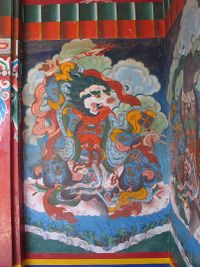
Jambavat was the 'Bear' among the Vanaras, who lived in the Kishkindha kingdom and fought on the side of the Rama together with the Varanas. Today there is a Peer Kho cave temple, in the city of Jammu overlooking the Tawi stream, which is said to be where Jambavat meditated.
Tibetan scriptures write of a people called 'kosa' in the general northwest region of the Subcontinent who had bodies like men, the faces of bears, and claws of iron.[19] In various scriptures, the Kosha tribe appears under names of its people, such as Domgyi mGocan (Skt: Rikshavaktra), Bear-headed one..That these 'heads' were mere masks can be seen in the description of Buddhist Saint Dorje Badane whose 3 dancers wear the masks of a lion, leopard, and bear.[20] A Naga (or klu-bdud) named Jo-bo-klu-bdud-mched-dgu is said to have had 9 black bear companions.[21]
The demonym 'Ṛkṣa' (or 'Riksha') implies that the tribe lives by the Riksha Mountains. This is in conformity with the geography of the Ramayana.
An ancestor of the Pandavas and Kauravas was King Rska, born to King Ajamidha by his wife [also named] Riksha.[22]
Other persons of this gotra mentioned by Tibetan scriptures includes, Mamo (also called Domgyi Gochen), Domgyi gLang-sNying (Head of a bear), Domgo Ma (Bear-headed Indrani), the Bonpo goddess gTumchen-mi-bzad Domgyi mGocan[23], and the pious Bonpo guardian-king Minag Domgyi Gochen.
Sarabhas as griffons[edit]
Sarabha is also a totemic tribe name. It was also the name of an ethnic region in the list of given South Asian nations within the Mahabharata. The most notable Sarabha is Suluvesa, who fought Narasimha after the latter had gotten out of control. Apart from Jambavan, another non-Vanara in Sugriva's army was a Sarabha who was the son of Parjanya. Because Nakula Pandava had a banner of Sarabha on his chariot, it means he had its tribesmen in his army. Rakshasas from this tribe were Varbha and Nissarabha, both in the army of Ravana.
The Shabara-swamin is a commentary by sage Yudhishthira Mimamsaka on the Mimimsa Sutra of Rṣi Jaimini. The Mimamsa-Shabara-Bhashyam is a commentary by Halligrama Subha Shastri. Jain scriptures mentions a Kalasena who was leader of the forest Shabaras.[24] Rama had paid sage Sarabhariga homage. Another intellectual of this tribe was the composer of the Sarabha Upanishad.
The Sarabhapuriya Dynasty of Sarabhapur was of this lineage, particularly of the Amararya family. Its last known monarch was Jaya Bhattaraka.
The Buddhist Panchatantra writes of the Bodhisattva having been a Sarabha in 1 birth.
Jainism today mentions tribe. In the scripture Astapada the first Tirthankar Rishabh is compared to the 1 in its mythic shape;
- After bowing to Rishabh
- who is like the world-engenderring eight-legged Sarabha
- with a golden body
Just as Singh and other lion-associated surnames are used by mainly Indians of northwestern regions, so is Sarabha. An example is Kartar Singh Sarabha, a Sikh member of the Ghadar Party who was martyred fighting for the cause of India's independence in the 20th century. Present-day Orissa has people known as Sabaras and their Sabara chieftain Vishwavasu is notable. Nearby in Andhra Pradesh and Telangana, the Chenchu are a people who are also called Sabara.
Sarabhas may have been descended originally from Yama because both are of the Karakoram region and one of Yama's sons was named Sarabha.
Sringas as deer[edit]
Sringa was a rṣi whose name means deer.
Rohini, the daughter of Daksha was also known as 'Mrgasiras' (Head of a gazelle.)
Vānaras as monkeys[edit]
- See also: Hanuman's Kishkindha is in Kashmir
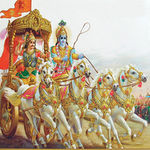
Hanuman belonged to the Vānara (Monkey) tribe whose flag has a monkey as its emblem. In fact the Jain Ramayanas call the Kishkindha Kingdom to which Hanuman belonged "Vānara-dhvaja Rajya" (Monkey-flag Kingdom.)
The kingdom of which he was a subject of was Kishkindha (or Kishkindha-puri) within Vānara-dvipa.
Hanuman of course was an Adivasi (tribal) soldier of the Kishkindha Dynasty.
In the Jain Ramayanas, such as the Paumarcharyam and Trishashtishalaka-Purusha Charitra, neither Hanuman nor Anjana (his mother) are monkeys in physical form but mere humans, as are the rakshasas and others such as, Jambavan and Garuda. The scriptures mention that the Vidyadharas sport monkey flags.
Vārahas as boars[edit]
Emusha Varaha was the name of the soldier that defeated the Daitya Hiranyaksha. The name itself means boar. The story entails a princess named Bhu (Earth) being kidnapped by Hiranyaksha and held captive in the Daitya realm of Rasātala. Hence, the story was condensed to a demon having taken 'the earth' to the underworld, and a boar then came to fight the demon to save the world. The Varaha gotra is mentioned in the Rig Veda[25] and the Atharva Veda[26].
Varaha-kshetra or Varaha's land is in Kashmir, more specifically in Baramulla as the very name of the district is Varaha. Other places, such as Wā'rāgām[27] and the Nilamata Purana mentions a Varaha-tirtha for pilgrimage. King Lalitaditya (724-761 CE) according to the Rajatarangini is said to have built a Maha-Varaha temple at Parihasapura (modern Paraspor.) There are 2 noteworthy images depicting Varaha in Devasar. According to the Vishnudharmottara Purana, Nrvaraha (like Vishnu) should be represented on Seṣa.
| He (Varaha) was besmeared all over his body with the blood of the Daitya (Hiranyaksha); and thus He came up from the Rasâtala and placed the earth on the waters. He then went away to His Vaikuntha abode. | ||
—Bhagavatam 2.34-38[28] | ||
Kuṣilāvacārya was "the preceptor of the boars." Other noteworthy Varahas include Varahakarna Yaksha in the palace of Kubera[29] and Varahamba the Asura mentioned in Mahabharata[30]. Mihira is noteworthy because he wrote the Varahamihira.
King Bhauma Gupta was responsible for having an image of the Varaha avatar, according to the Gopalaraja Vamsavali. The Barman Dynasty, which succeeded from the Bhauma Dynasty too had the imperial title ‘Sri Varaha’. This means both dynasties identified their gotra as Varaha.
Jain Varahas mentioned, include Manibhadra and Purnabadra Yakshas, and Bahuputrika Yakshini. Manibhadra and Purnabadra have been mentioned as Yakshas of Mahavira.[31] Manibhadra and Purnabadra were chiefs of Yakshas; Manibhadra of northern ones and Purnabadra of southern ones. Varahaka was a female disciple of Pushpadanta.
Vajrakarna and Buddhist Vajravarahi are 2 other mentioned people of the Varaha gotra. The Manibhadras are a section of Varahas, mentioned in the Mahabharata, and in Buddhism, and Jainism.
More dynastic totemic iconography[edit]
| Flag | Dynasty | Region | Period of governing |
|---|---|---|---|
| Chola | India: Tamil Nadu, Kerala, Andhra Pradesh, Karnataka Indonesia |
||
| Kandyan | Lanka | ||
| Kanker | Chhattisgarh | ||
| Keonjhar | Odisha | ||
| Khairagarh | Chhattisgarh | ||
| Khilchipur | Madhya Pradesh | ||
| Kochin | Kerala | ||
| Kota | Rajasthan | ||
| Lunavada | Gujarat | ||
| Narsinghgarh | Madhya Pradesh | ||
| Nayagarh | Odisha | ||
| Pandya | Tamil Nadu, Kerala, Andhra Pradesh, Karnataka | ||
| Pal Lahara | Odisha | ||
| Pudukkottai | Tamil Nadu | ||
| Rajgarh | Madhya Pradesh | ||
| Ratlam | Madhya Pradesh | ||
| Seraikella | Jharkhand |
See also[edit]
External resources[edit]
References[edit]
- ↑ Miharban Janam-sakhi and Puratan Janam-sakhi
- ↑ Vamana Purana 37.16.23
- ↑ P. 47 INDIA: Brief History Volume 1 By Symist
- ↑ A Handbook Of Tibetan Culture By Graham Coleman
- ↑ Mahabharata 8.6.16 THE SEVENTH BOOK Chapter VIII On the King Revata and the Solar Dynasty
- ↑ Vajra Suchi by Asvaghosha TRANSACTIONS OF THE ROYAL ASIATIC SOCIETY OF GREAT BRITAIN AND IRELAND [Transactions, Volume III] [London, J. Murray and Parbury, Allen & Co.] [1835] {Scanned and edited by Christopher M. Weimer, May 2002}
- ↑ P. 164 Encyclopaedia of Religion and Ethics: Mundas-Phrygians By James Hastings, John Alexander Selbie
- ↑ Varuna is described as having 3 eyes, a bull for a vehicle, and matted hair.
- ↑ Studies in Ancient History: The Second Series; Comprising an Inquiry Into the Origin of Exogamy By John Ferguson McLennan and Eleanora Anne Brandam McLennan
- ↑ P. 145 Ancient Communities of the Himalaya By Dinesh Prasad Saklani
- ↑ Seeing Spiritual India: A Guide to Temples, Holy Sites, Festivals and Traditions By Stephen Knapp
- ↑ P. 128 Asian Mythologies By Yves Bonnefoy
- ↑ Yoga Sutra 1.11.281
- ↑ Taitt. Samhita 4.5
- ↑ P. 225 Essays On Indo-Aryan Mythology-Vol. By Aiyangar Narayan
- ↑ Srimad Bhagavatam 6.6.29-31
- ↑ SB 6.6.29-31
- ↑ Vinaya Pitaka (I, 3)
- ↑ P. 490 The Nyingma School of Tibetan Buddhism: Its Fundamentals and History By Dudjom Rinpoche, Gyurme Dorje
- ↑ P. 63 Tibetan Religious Dances: Tibetan Text and Annotated Translation of the 'Charms yig By René de Nebesky-Wojkowitz, Dalai Lama V Ṅag-dbaṅ-blo-bzaṅ-rgya-mtsho
- ↑ P. 266 An Encyclopaedia of Buddhist Deities, Demigods, Godlings, Saints and Demons: With Special Focus on Iconographic Attributes, Volume 1 By Fredrick W. Bunce
- ↑ P. 80 Early Indian Historical Tradition and Archaeology: Purāṇic Kingdoms and Dynasties with Genealogies, Relative Chronology and Date of Mahābhārata War By G.P. Singh
- ↑ P. 1313. Buddhist iconography: Lokesh Chandra. Begun by the late Prof. Raghu Vira. Dictionary of buddhist iconography : Dhyāna-pāramitā - Gzuṅs.las.byuṅ.baḥi lha.mo Nor.rgyun.ma By Lokesh Chandra, International Academy of Indian Culture
- ↑ P. 513 Indian Kavya Literature, Volume 4 By A. K. Warder
- ↑ 1.61.7 ; 8.77.10
- ↑ 8.7.23
- ↑ East of Drang in Biru; P. 166 Place Names in Kashmir By Shyam Lal Sadhu
- ↑ Devi Bhagavatam 2.34-38 THE EIGHTH BOOK Chapter II On the uplifting of the Earth by the Sacrificial Boar
- ↑ Mahabharata, Sabha Parva, Chapter 13, Stanza 16
- ↑ Mahabharata, Santi Parva. Chapter 227, Stanza 52
- ↑ P. 188 Prakrit Narrative Literature: Origin and Growth By Jagdish Chandra Jain

